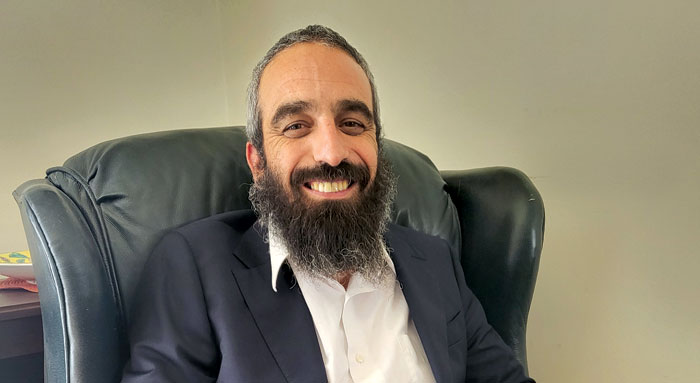The counting of peoples and characteristics is a science and art, as well as a fairly expensive and labor-intensive undertaking when done properly. Demography is often not an easily understood topic. It’s common to find inflated and even improbable population estimates in major newspapers that gain currency just because they appeared there.
We are perhaps too familiar with Anthony Gordon and Richard Horowitz’s widely distributed Jewish population projection chart that surfaced a couple of years ago. The graphic appeared in ads in The Jewish Journal, as well as in Moment magazine, The Jewish Spectator and as a theme in Alan Dershowitz’s book, “The Vanishing American Jew.” The widely disseminated chart was never submitted for professional or peer review but became part of the “common wisdom” in the United States and Israel, propelled by some political advocates.
The Gordon and Horowitz graphic chart portrays in stick figures a ninefold growth in the Orthodox population over four generations. In the meanwhile, Gordon and Horowitz project the populations of other Jewish denominations such as Reform to decline to a bit more than a tenth of current levels, and the nondenominational Jewish population to shrink even more after four generations. Basically, Gordon and Horowitz show in graphic terms that the non-Orthodox virtually vanish from the American landscape. Seeing that I have serious disagreement with their self-published study, Gordon and Horowitz are, of course, going to disagree with the findings of the 1997 Los Angeles Jewish Population Survey (LAJPS).In undertaking the 1997 LAJPS, I found 10,300 Orthodox households. I used the same general methodology as the previous 1979 Phillips survey and found a smaller percentage of Orthodox households, which in turn found less than the 1953 Massarik survey, which found 17,000 Orthodox households in Los Angeles. Nationally, the 1971 National Jewish Population Survey (NJPS) found that 8.4 percent of the households were Orthodox, and 19 years later, the 1990 NJPS showed that proportion of Orthodox households in the U.S. Jewish population had declined to 6.8 percent. There is a margin for error, but unless demographic trends reversed themselves, I stand by my judgment of the data.
Fortunately we will not have to wait four generations to see whether the 1997 LAJPS findings are out of line with national trends, as the 2000 NJPS results will be available by 2002, if not earlier.
-
I have found no data to support Gordon and Horowitz’s claimed increase in the L.A. Orthodox population between 1979 and 1997. I consulted Bruce Phillips, the 1979 LAJPS’s principal investigator and he concurred with me that there were no such supporting data.
-
Demographic comparisons are usually made by households. All the Los Angeles Jewish population surveys and all Jewish demographic surveys, including the 1990 and 2000 NJPS, use the same household method in allocating Jewish denominational affiliation, whereby the household respondent’s stated Jewish denominational affiliation is allocated to the members of the household. An interviewer doesn’t ask to speak to a 12-year-old or ask about a 12-year-old’s Jewish denominational affiliation; it’s assumed if the adult respondent is Orthodox, the 12-year-old is also Orthodox.
-
Gordon and Horowitz misunderstand the difference between family size and household size, which in L.A. is 2.7 persons for the Orthodox. Birthrates remain highest among the Orthodox, though the Orthodox fertility picture is mixed. A preeminent expert on American Jewish Orthodoxy, Sam Heilman, wrote in 1995 that 22 percent of the most traditionally observant had just over four children per family, 60 percent of those who called themselves Orthodox had just under three children per family and the remaining 18 percent of Orthodox families had children at replacement level (2.1 children per family).
-
The Orthodox Union’s top professional staff and top lay chair were invited for their personal attendance or written input at a 1995 survey planning. Gordon and Horowitz’s claim to demographic scholarship was not public until two years later, when their chart made the head-lines in the locally published Heritage Southwest Jewish Press.
-
Timing is everything. When one undertakes a Jewish demo-graphic telephone survey, it is vital to be guided by the Jewish calendar. By direction and contract, no calls on Friday, Saturday and Jewish holidays were made by the interview firm.
-
Gordon and Horowitz were refused the raw data when they demanded it over the phone in the summer of 1998 because The Jewish Federation sequestered the data for a two-year period of proprietary analysis. Since then, Gordon and Horowitz have not telephoned me. For those interested, a detailed survey methodology report (in the publication “Los Angeles Jewish Population Survey ’97”) and the raw numbers (in the “Needs of the Community” publication) are available from The Jewish Federation planning and allocations department to anyone who wants them. The raw survey data file has been available to the public from the National Jewish Data Archive (www.jewishdatabank.com) since 1999.
A demographic study is a mirror of a community and often elicits great interest for people who are intensely involved in that community. The more intensely invested and involved people are, the greater the difficulty for them to be objective. That is why a discipline of rigorous methodology and analysis are required to ensure that the community is reflected with a minimum of distortion. The 1997 Los Angeles Jewish Population Survey achieved that.






















 More news and opinions than at a Shabbat dinner, right in your inbox.
More news and opinions than at a Shabbat dinner, right in your inbox.